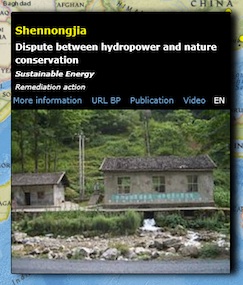Remediation action in Shennongjia biosphere reserve.
 With abundant rain and water resources and a mid-latitude location, Shennongjia is home to more than 3,700 kinds of plants and at least 1,060 species of animals, including the famous golden monkeys. About 96 percent of the reserve is covered by primeval forest, including hundreds of square kilometers that haven’t been explored.
With abundant rain and water resources and a mid-latitude location, Shennongjia is home to more than 3,700 kinds of plants and at least 1,060 species of animals, including the famous golden monkeys. About 96 percent of the reserve is covered by primeval forest, including hundreds of square kilometers that haven’t been explored.
The development of hydropower in Shennongjia forest district in Hubei province dates back to the 1970s, when the region’s government encouraged locals to use hydropower as an alternative to wood as fuel for better preservation of forests.
However, hydropower stations are a double-edged sword. On the one hand, forest resources have been well preserved as fewer trees fell. However, rivers in the forest district have been cut off after nearly 100 small hydropower stations were built.
In 2006, the government of the forest district stopped approving hydropower stations below 3,000 kilowatts and vowed to shut down 38 small stations before 2020. Yet no stations have been closed since, as they are indispensable in providing cheap electricity to locals.















